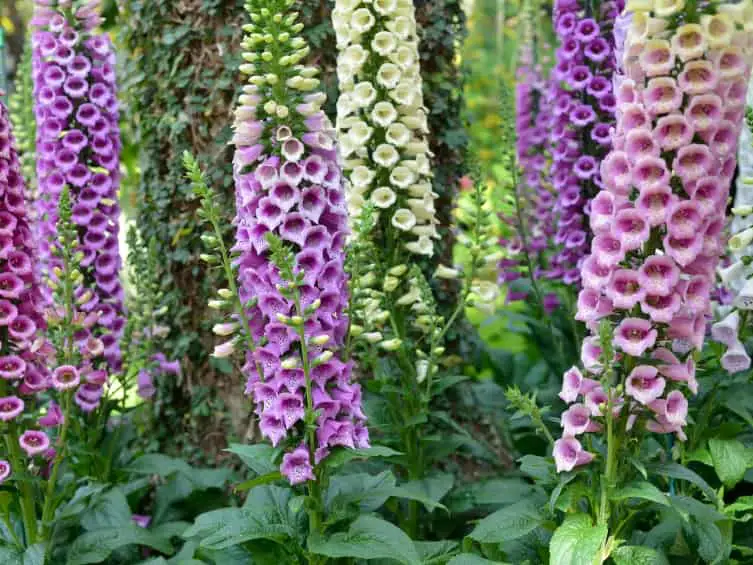Foxglove, known for its tall spikes and bell-shaped flowers, adds drama to any garden. Its vertical presence creates a striking visual impact in flower beds and borders. Proper care ensures healthy growth and prolonged blooming, making it a favorite for gardeners seeking vibrant summer color.
These biennial or short-lived perennial plants require attention to soil, sunlight, and watering for peak performance. Understanding their needs and following best practices allows foxglove to thrive year after year. This guide offers detailed insights into every aspect of foxglove care, from planting to pest management, helping gardeners cultivate flourishing, show-stopping plants.
Understanding Foxglove Growth and Characteristics

Foxglove, belonging to the genus Digitalis, is valued for its tall, dramatic flower spikes and bell-shaped blooms. Plants usually grow between three and six feet, making them ideal for vertical accents in borders or cottage gardens. The first year of growth typically forms a basal rosette of leaves, which store energy for the flowering season. In the second year, tall spikes emerge, covered in tubular flowers that attract pollinators such as bees and hummingbirds.
The flower colors range from soft pinks, purples, and whites to deeper shades of crimson or spotted varieties. Each bell-shaped flower can measure several centimeters, often displaying intricate speckled patterns inside. While foxglove is visually stunning, it is highly toxic if ingested. All parts, including leaves, flowers, and seeds, contain cardiac glycosides, so careful placement away from children and pets is crucial.
Foxglove thrives in cool, temperate climates but can adapt to warmer regions with appropriate care. It prefers rich, well-draining soil and a location with partial shade to full sun. Humidity, temperature fluctuations, and soil fertility influence bloom timing and flower size. Being biennial, foxglove requires planning to maintain continuous flowering in the garden. By staggering plantings or growing a mix of biennial and short-lived perennial varieties, gardeners can enjoy vibrant, tall, and resilient flower displays from spring through summer, adding both height and color to any landscape.
Choosing the Right Location and Soil
Selecting the ideal location is essential for foxglove success. These plants thrive in areas with partial shade to full sun, depending on climate. In hot regions, morning sun with afternoon shade prevents leaf scorch and flower wilting. Cooler areas can tolerate full sun, which encourages taller spikes and more abundant blooms. Proper sunlight exposure ensures photosynthesis supports strong leaf and flower development throughout the growing season.
Soil quality directly impacts foxglove health. Well-draining, fertile soil enriched with organic matter encourages deep root growth and reduces the risk of waterlogging. Loamy or sandy soils work best, while heavy clay soils should be amended with compost or grit. The preferred pH range is slightly acidic to neutral, between 6.0 and 7.0. Mulching around the base helps retain moisture, regulate soil temperature, and suppress weeds. Consistent moisture combined with fertile soil promotes vigorous foliage and large, vibrant flower spikes. Proper site selection and soil preparation create optimal conditions for foxglove growth, ensuring plants develop strong roots, tall flowering stems, and long-lasting blooms. Gardeners who carefully choose location and soil provide the foundation for a thriving, visually striking display of foxglove in any garden.
Planting Foxglove Successfully
Foxglove can be grown from seeds, nursery seedlings, or transplants. Direct sowing outdoors is ideal in early spring or fall. Seeds require light to germinate, so sprinkle them on the soil surface without covering deeply. Keep the soil evenly moist until seedlings emerge, which usually takes two to three weeks. Thin seedlings to about 12 to 18 inches apart to allow airflow and prevent disease.
When planting nursery-grown seedlings or transplants, dig a hole twice the width of the root ball. Gently place the plant in the hole and backfill with nutrient-rich, well-draining soil. Water immediately to reduce transplant shock and help roots establish. Staggering plantings ensures continuous blooms in the garden, with younger plants ready to flower as older ones fade. Proper spacing prevents overcrowding and encourages healthy growth. Foxglove prefers rich soil and consistent moisture, so applying mulch around the base conserves water and suppresses weeds. With careful planting techniques, foxglove establishes strong roots, produces tall flower spikes, and develops vibrant blooms. Well-planned planting not only maximizes flower performance but also supports plant longevity, making foxglove a reliable and visually striking addition to any garden.
Watering and Moisture Management
Maintaining Consistent Soil Moisture
Foxglove prefers consistently moist soil, especially during hot or dry periods. Deep watering encourages roots to grow downward. This supports taller, stronger flower spikes. Shallow or irregular watering can cause stunted growth, leaf curling, or fewer blooms. Mulching around the base helps retain moisture, regulate soil temperature, and reduce water evaporation. Check soil regularly; it should feel damp but not waterlogged. Proper moisture management is critical for overall plant health and flower development. Maintaining consistent soil moisture ensures vibrant leaves, robust stems, and long-lasting blooms throughout the growing season.
Preventing Fungal Problems
Overly wet conditions can encourage fungal issues such as powdery mildew or root rot. Avoid overhead watering in humid climates to reduce leaf wetness. Provide adequate spacing between plants to improve airflow and reduce humidity around foliage. Remove any infected leaves promptly to prevent spread. Well-draining soil combined with careful watering practices minimizes fungal risks. Consistently monitoring moisture levels and environmental conditions helps foxglove stay healthy, ensuring that flowers remain vibrant and plant structure strong from spring through summer.
Fertilizing for Healthy Growth
Choosing the Right Fertilizer
Foxglove benefits from nutrient-rich soil and supplemental feeding during the growing season. Use a balanced fertilizer or one slightly higher in phosphorus to encourage strong flower development. Avoid excessive nitrogen, which promotes leafy growth over blooms. Organic options like compost or well-rotted manure enrich the soil naturally, improve structure, and provide slow-release nutrients. Fertilizing at the right time supports vigorous stems, lush foliage, and larger flower spikes. Proper fertilizer selection ensures plants receive the nutrients needed to thrive and produce vibrant, long-lasting flowers.
Application and Frequency
Apply fertilizer every four to six weeks during active growth. Follow the manufacturer’s recommended dosage to avoid over-fertilizing, which can damage roots or leaves. Water plants after feeding to help nutrients absorb efficiently. Combining regular fertilization with consistent moisture promotes energy allocation for flower production and root development. Well-fed foxglove plants bloom more abundantly and resist environmental stress better. Properly timed feeding enhances the overall health of the plant, supporting continuous growth, stronger stems, and extended flowering periods. Regular fertilization is essential for maintaining thriving foxglove in any garden.
Pruning and Deadheading Practices
Deadheading for Prolonged Blooming
Deadheading spent foxglove flowers is essential to extend the blooming period. Removing faded blooms redirects energy toward new bud formation, promoting additional flowering. Cut just above the basal rosette or healthy leaves to avoid damaging plant tissue. Regular deadheading also prevents unwanted self-seeding, helping maintain garden design and spacing. By continuously removing old flowers, plants remain visually appealing and productive throughout the growing season. Deadheading is particularly important for biennial varieties to maximize their second-year flowering potential. Consistent attention ensures plants focus resources on producing strong, healthy spikes.
Pruning to Maintain Plant Health
Light pruning improves airflow, reduces disease risk, and shapes the plant. Remove weak, overcrowded, or damaged stems carefully. Avoid cutting basal leaves, as they store energy needed for next season’s growth. Pruning encourages stronger, more upright flower spikes, making plants less prone to bending or breakage. In combination with proper watering and fertilization, pruning supports vigorous growth and vibrant blooms. Strategic trimming prevents fungal infections by improving air circulation and reducing humidity around foliage. Maintaining good structure also enhances garden aesthetics, keeping foxglove neat and striking. By integrating deadheading and pruning, gardeners ensure continuous flowering, healthier plants, and prolonged visual appeal from spring through summer.
Supporting Tall Flower Spikes
Foxglove flowers can reach up to six feet, making support essential for stability. Tall spikes are prone to bending or breaking, especially in windy or exposed locations. Using stakes, cages, or trellises helps keep stems upright and prevents damage. Tie stems loosely with soft ties to avoid constricting growth or cutting into plant tissue. Supports should be installed early in the season before stems become rigid and brittle.
Grouping plants together can also provide mutual support, as stems lean on each other for stability. Choose materials that blend with the garden aesthetic while offering strong, reliable support. Proper staking ensures all flowers remain visible, maximizing their dramatic visual impact. Maintaining vertical growth not only enhances garden beauty but also improves airflow around the plant, reducing fungal disease risk. Monitoring supports throughout the season is important, as ties may need adjustment as plants grow. Well-supported foxglove spikes highlight their striking form, prevent unnecessary damage, and ensure the full height and floral display is maintained for an extended period. Strong, upright stems also allow better access for pollinators, increasing seed production for future plantings. Providing adequate support is a key practice for achieving vibrant, long-lasting foxglove displays that thrive year after year in any garden environment.
Protecting Against Pests and Diseases
Common Pests
Foxglove can attract several pests, including aphids, slugs, and snails. Aphids feed on sap, causing leaf curling, yellowing, and stunted growth. Inspect plants regularly and remove pests manually or use insecticidal soap for control. Slugs and snails can chew holes in leaves, weakening the plant. Barriers, traps, or natural predators like birds help reduce their numbers. Early detection and consistent monitoring prevent severe damage. Healthy plants are more resistant to pest attacks, so maintaining strong growth with proper watering, fertilization, and sunlight is essential. Regular checks also ensure pests don’t spread to other garden plants.
Fungal and Bacterial Diseases
Fungal issues such as powdery mildew, leaf spot, and root rot can occur in damp, poorly ventilated conditions. Avoid overhead watering and provide adequate spacing between plants to improve airflow. Remove affected leaves promptly to prevent further spread. Using well-draining soil and applying mulch helps reduce humidity at the base. Bacterial infections are less common but can cause leaf wilting and discoloration. Sanitize tools and avoid working on wet plants to prevent transmission. Monitoring for early signs, maintaining proper soil moisture, and removing diseased plant parts are key to protecting foxglove from fungal and bacterial threats, ensuring healthy growth and vibrant blooms.
Winter Care and Biennial Planning
Preparing Foxglove for Winter
Foxglove is a biennial plant, so winter care is essential for survival and next year’s flowering. In colder climates, mulch heavily around the base using straw, leaves, or compost. This insulates roots from frost and temperature fluctuations. Potted foxglove should be moved to a sheltered location or indoors. Reduce watering during winter to prevent root rot while keeping soil slightly moist. Remove dead or diseased foliage to reduce fungal infections. Proper winter care ensures the plant retains energy for the second-year bloom, leading to healthy, tall, and vibrant spikes in spring and early summer.
Planning for Continuous Bloom
Since foxglove is biennial, gardeners must plan plantings to maintain consistent flowering. Stagger sowing seeds over several weeks to ensure a continuous display of blooms. Direct sow seeds in late spring or early summer to establish young plants before winter. Maintain healthy seedlings and transplant them carefully in the first year. Combining biennial and short-lived perennial varieties allows for a more extended flowering period. Proper planning also involves saving seeds from mature plants for next season. Strategic winter care and biennial planning provide a reliable cycle of foxglove blooms year after year, ensuring a visually striking and sustainable garden display.
Propagation Techniques
Foxglove can be propagated from seeds, cuttings, or by transplanting young plants. Seed propagation is the most common and reliable method. Sow seeds directly on the soil surface in late spring or early summer. Lightly press them into the soil without covering, as they need light to germinate. Keep the soil evenly moist until seedlings emerge, usually within two to three weeks. Thinning seedlings ensures adequate spacing and airflow, preventing disease and encouraging strong growth. Biennial varieties require careful timing to ensure the first-year rosettes survive winter and bloom the following year.
Propagation from cuttings is less common but possible with softwood shoots in spring. Use a sharp, sterilized tool and plant cuttings in a well-draining medium. Maintain high humidity and bright, indirect light until roots form. Transplant young plants carefully, keeping roots undisturbed, and water thoroughly. With proper propagation techniques, foxglove can be continuously established in the garden, maintaining healthy, tall flower spikes and ensuring a consistent supply of vibrant blooms season after season. Strategic propagation supports both biennial cycles and long-term garden aesthetics.
Troubleshooting Common Problems
Addressing Watering and Nutrient Issues
Wilting leaves often result from inconsistent watering or dry soil. Deep, even watering helps keep roots moist without waterlogging. Yellowing foliage may indicate nutrient deficiencies or poor drainage. Applying a balanced fertilizer and improving soil structure restores plant health. Monitoring soil moisture regularly prevents stress and supports consistent growth. Well-hydrated plants develop stronger stems and more vibrant blooms. Consistent care during hot or dry periods reduces the risk of stunted growth or flower loss. Observing the plant’s condition allows early detection of issues, making intervention more effective. Maintaining proper watering and nutrient levels ensures foxglove thrives, producing tall spikes and colorful flowers throughout the season.
Controlling Pests and Fungal Diseases
Foxglove is susceptible to pests like aphids, slugs, and snails, which damage leaves and stems. Manual removal or insecticidal treatments help manage infestations. Fungal diseases, such as powdery mildew and leaf spot, thrive in damp, crowded conditions. Increase airflow, avoid overhead watering, and promptly remove affected leaves. Root rot occurs in poorly draining soil, which can be mitigated by soil amendment or repotting. Early intervention prevents widespread damage. Regular inspection helps detect pests and disease before severe problems develop. Healthy plants are more resistant to both pests and fungal infections, ensuring long-lasting, vibrant flower spikes that enhance the garden’s visual appeal.
Expert Tips for Thriving Foxglove
Maximizing Flower Size and Color
Choose foxglove varieties suited to your climate for optimal growth. Adequate sunlight encourages taller spikes and more vibrant blooms. Partial shade works well in hot regions to prevent leaf scorching. Apply a phosphorus-rich fertilizer during the growing season to enhance flower size and intensity. Consistent moisture and well-draining soil support strong roots, which produce healthier stems and longer-lasting blooms. Deadhead spent flowers to redirect energy toward new bud formation. Pruning tangled or weak stems improves air circulation and reduces disease risk. Healthy plants maintained with these practices produce striking floral displays and contribute to a visually dynamic garden.
Extending Blooming Season
Stagger planting times to ensure a continuous display of flowers throughout the season. Combine biennial and short-lived perennial varieties for longer flowering periods. Regular deadheading encourages additional bud formation and extends bloom duration. Maintain consistent watering, fertilization, and mulching to support ongoing growth. Protect plants from extreme weather and pests, which can disrupt flowering. Strategic care during the pre-bloom and bloom phases maximizes flower longevity. By following these expert practices, gardeners can enjoy abundant, tall, and vibrant foxglove spikes, ensuring a sustained, visually appealing garden display from spring through summer.
Container Gardening for Foxglove
Growing foxglove in containers is ideal for small gardens, patios, or spaces with poor soil. Choose a large pot at least 12 inches deep and wide to accommodate the plant’s deep roots and tall flower spikes. Ensure the container has drainage holes to prevent waterlogging, which can lead to root rot. Use a high-quality, well-draining potting mix enriched with compost or slow-release fertilizer to provide nutrients for healthy growth.
Position the container in a location with partial shade to full sun, depending on your climate. In hotter regions, morning sun with afternoon shade prevents leaf scorch. Water consistently, keeping the soil moist but not saturated. Mulching the surface helps retain moisture and regulates soil temperature. Fertilize every four to six weeks during active growth for vigorous stems and prolonged blooming. Support tall spikes with stakes or cages to prevent bending. Container gardening allows easy relocation to optimize sunlight, shelter from extreme weather, and highlight flowers. Proper care ensures foxglove thrives in limited spaces, producing vibrant, long-lasting blooms year after year.
Companion Planting and Garden Design
Foxglove pairs well with other perennials and annuals to create visually striking garden displays. Plants like lupine, delphinium, and hollyhock complement foxglove’s tall spikes with contrasting colors and textures. Lower-growing flowers such as pansies, alyssum, or primrose provide a lush, colorful base that enhances foxglove’s height. Combining plants with different bloom times ensures continuous visual interest throughout the season.
When designing a garden, consider plant spacing and sunlight requirements. Place foxglove toward the back of borders or along fences to showcase its height. Ensure companion plants receive adequate light and airflow to minimize disease risks. Incorporate mulching and edging to maintain neat planting areas. Stagger plant heights and bloom cycles to avoid crowding and create depth. Companion planting also supports pollinators, attracting bees and butterflies to the garden. Thoughtful arrangement emphasizes color contrast, seasonal variation, and structural diversity. By planning companion plants carefully, gardeners can create harmonious, dynamic flower displays while promoting foxglove health and extended blooming periods. Proper garden design enhances aesthetics, plant vigor, and long-term sustainability.
FAQ About How to Care for Foxglove
What is the ideal soil type for foxglove?
Foxglove thrives in well-draining, nutrient-rich soil with a slightly acidic to neutral pH. Adding compost improves fertility and structure. Avoid heavy clay or waterlogged soils, as they can cause root rot and stunt growth. Regularly checking soil moisture and texture ensures healthy root development and vigorous flower spikes. Proper soil preparation supports strong stems, abundant blooms, and overall plant longevity.
How often should I water foxglove?
Foxglove requires consistent moisture, especially during hot or dry periods. Water deeply at the base to encourage strong root growth. Avoid overhead watering to reduce fungal disease risk. Mulching helps retain soil moisture and regulate temperature. Adjust frequency based on rainfall, temperature, and container versus ground planting. Maintaining even moisture promotes taller spikes and prolonged flowering.
Can foxglove be grown in containers?
Yes, foxglove grows well in large pots with good drainage. Choose containers at least 12 inches deep and wide. Use well-draining potting mix enriched with compost. Position in partial shade to full sun depending on climate. Regular watering, fertilization, and staking support healthy growth and abundant blooms. Container gardening allows mobility for optimal sunlight and protection from extreme weather.
How do I prevent common pests and diseases?
Inspect plants regularly for aphids, slugs, and snails. Remove pests manually or use safe insecticidal treatments. Increase airflow to reduce fungal issues like powdery mildew. Avoid overhead watering and remove infected leaves promptly. Well-draining soil and healthy care minimize disease risk. Early intervention prevents severe damage and keeps foxglove vibrant.
How can I extend the blooming period of foxglove?
Deadhead spent flowers to redirect energy toward new buds. Stagger planting times or mix biennial and short-lived perennial varieties for longer bloom cycles. Provide consistent moisture, fertilization, and support for tall spikes. Protect plants from extreme temperatures and pests. Strategic care ensures continuous, tall, and vibrant flower displays throughout the growing season.
Conclusion
Caring for foxglove involves proper sunlight, soil, watering, and fertilization. Deadheading, pruning, and staking improve bloom longevity. Propagation and biennial planning ensure continuous flowering. Protecting plants from pests, diseases, and extreme weather maintains healthy growth. With careful attention, foxglove provides striking, vertical blooms that enhance any garden year after year, offering vibrant color, texture, and visual appeal from late spring through summer.






